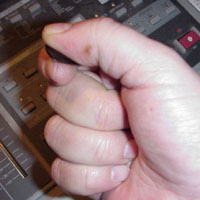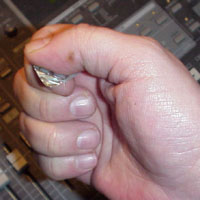

![[Previous Page]](prev.gif)
![[Next Page]](next_dis.gif)
![[Up]](up.gif)
![[Home Page]](home.gif)
![[Mail]](mail.gif)
![[Contents]](contents.gif)

This is what the lefthanded players do with their left hand... the picking.
When I started playing, I really wondered that you do the more complicated stuff (I thought it was playing chords) with the hand that is not your prefered hand. Many years later I realized that the more complex thing is the picking. Keep in mind that the mother of your sound is your picking technique. Not so much, when you are just strumming away some chords, but you can create a variety of sounds just with your pick. The sound depends on how hard you pick and at which position of the string and the tip of your pick and in which angle your pick touches the string.
The picking is a very complex thing, that is kinda hard to describe. It starts at your shoulder, elbow and wrist are involved and ends at your fingers and the tip of your pick. The farther away from the shlouder, the more precize is the movement.
The pick you play should pay justice to that precision. A soft and flexible pick might be ok for strumming chords, but for single note lines a hard and not flexible pick should work better. Personally I like to play those tiny little Jim Dunlop Stubby Picks (3mm). They look like cough drops and you definately have to get used to them. They are too tiny to strum chords, but rounded edges give me wider variety of sounds, I think.
The way you hold the pick is the deciding factor of how you will sound. The pick should be held more or less firmly between thumb and index finger.The firmer you hold the pick, the harder the attack. This is another disadvantage of soft (light) pick... you always have a soft attack, thus you limit your expression.
 This works for single note lines |
 This works for strumming chords |
For playing single note lines (solo) you hold the pick mainly between thumb and index finger all other fingers are not involved a lot. This allows you very precise movements like when you are writing.
If you want to strum away some chords, you can use the other fingers to support the index finger, so you make contact between them and the index finger. The fingers are kinda parallel.
The next important subject is the way you combine up-picks and down-picks (this is not about playing chords!). If you would only play down-pick, you would have to move the pick back to the "start position" before you can play the next note. Actually this move back is already kinda up-pick without touching the string. Apparently it is way more economical to combine down-picks and up-picks alternately. What you pick is down, up down, up, down, up and so on. The tip of the pick performs a small circular movement. This technique is called sweep picking or alternate picking. It also helps you to improve your timing.
Now imagine you have just played an up-pick on the G string and the next note you want to play is at the D string (which is above the G string). Your next pick would be a down-pick. Thus you would have to move the tip of your pick from under the G string all the way to above the D string. Actually this is not very econimical, right?
An advanced picking technique is to make use of the movement to the next string. So, if you move up your pick to the next string, the following pick will be an up-pick, no matter if the pick before was an up- pick or down-pick. if you move your pick down to the next string, the following pick is a down-pick.
Make sure that you are good in sweep picking before you start to practice this advanced picking technique. It is important to learn to synchronize the movements of your left hand and your right hand.
Finding the differences of sound by changing the way you pick is something you have to experience yourself. Variing the position where you pick the string and the angle between the string and the pick and how firm you hold the pick results in many slightly different sounds, thus a wider range of expression (that is what music is about). The goal is that you make use of all that and that picking becomes a subconscious process. It can only be reached by playing a lot.
I can't tell you a lot about finger picking techniques, since I have never learned classical guitar. I only use finger picking to play chords in a similar way, you can play them on a piano. That means to play several notes at the exactly same time, which cannot be done by strumming the chord. This can be both. playing the bass note with the thumb and up to 4 notes with the other fingers (fingernails) or playing the bass note with the pick held by thumb and index fingers and three notes with the other fingers.
Thumb picking gives you a really warm sound, which is suitable for e.g. jazz comping (playing chords). This is accomplished by striking the string(s) with the fleshy part (side and tip) of your thumb. It can even be used to play single note lines, but it requires a lot of practicing to get speed with this picking technique and it is not very loud. It results in a warm and sweet sound, though.
Muting strings with the side of your right hand gives a very short sustain. It is good for some percussive playing or even for faking a precussion instrument like congas. It should be done close to the bridge or right at the bridge, because you still want to play in tune. And it is easier to control at that position.
The controlled use of harmonics is a pretty spectacular effect. That is strinking a string in a way that is doesn't vibrate in the fundamental frequency of the tone you have freted, but an octave (twice the frequency), an octave plus a fifth (three times) or two octaves (four times) higher than it. This is acomplished by troching the string with the fleshy part of your thumb a very short time after you have stroke it with your pick at a suitable point. Those points can be found at 1/2, 1/3 or 1/4 of the way between the bridge and the fret you play. This technique works best with a distorted sound on your bridge pickup. The neck pickup is usually not the pickup of your choice for that technique.
I play it with down-picks only and hold the picvk in a way that the side of my thumb touches the string right after picking. Try it out this way:
Fret the g-string at the 12th fret. Play down-picks in a way I have described before right over the position of an imaginary 24th fret. That is usually right above the neck pickup. Vary that position slightly and find the point where it works best. Now try it at the other points to get third and forth order harmonics. It is obvious that you have to find all the different points for every different tone (fret) you can play on a string. That is not easy and requires some practicing.
You can also make use of that technique by not fully muting the fundamental frequency of the string to vary your tone.

| [Previous] | Left hand technique |
| [Up] | The Basics - not just for beginners |
| [Home] | Home Page |
| [Mail] | Send EMail to Sven's Guitar Site |
| [Contents] | Sven's Guitar Site Contents |

Last modified on Monday, 25. September 2017